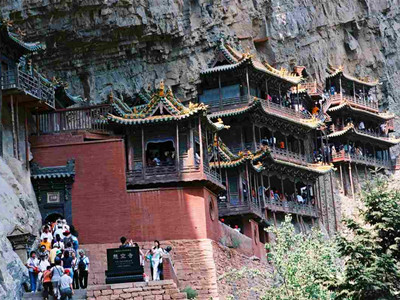Hanging Temple [ Related Itinerary ]
 Located at the foot of Mt. Hengshan, 65 kilometers from Datong city center, the Hanging Temple is the only one reserved temple which combines Buddhism, Taoism and Confucianism. For a distant view, the temple looks as if hanging in the mid air miraculously, so got the name "Hanging Temple". With the history of more than one thousand years, it is the must-see during the tour in Datong.
Located at the foot of Mt. Hengshan, 65 kilometers from Datong city center, the Hanging Temple is the only one reserved temple which combines Buddhism, Taoism and Confucianism. For a distant view, the temple looks as if hanging in the mid air miraculously, so got the name "Hanging Temple". With the history of more than one thousand years, it is the must-see during the tour in Datong.Hanging Temple was originally built in 491 during the Northern Wei Dynasty (386-534). In Ming (1368-1644) and Qing (1644-1911) Dynasties, the monastery experienced the large-scale reconstructions. Facing a deep valley, leaning on the steep mountain, the temple was constructed in a unique way: all the buildings are supported by crossbeams - wooden pillars which are inserted in holes cut in the mountain. Originally, the highest point of the Hanging Temple was about 90 meters high, however, as time goes by and the erosion by the wind and sand, the highest point now is only about 58 meters.
No historical materials record the reason why the Hanging Temple was built against the cliff. Whatever the architecture embodies a great cultural achievement of Chinese people. The monastery has three features: unique, hanging and dangerous, ingenious. Unique indicates its unique location. The monastery leans against the steep cliff and stands on the wooden crossbeams, so for a distant view, it looks just as a tumble-down castle in the air. Hanging and Dangerous has two meanings. Firstly, the hanging indicates that this monastery is hung on the cliff. Secondly, dangerous also means "insecure". It is said that there were not any crossbeams under it when this monastery was firstly be built. And at the beginning, the monastery was about 90 meters high. People were afraid of stepping onto this monastery, so the second feature can be called as Dangerous. Ingenious reflects the special architectural design of the monastery.
Built on a sheer precipice, the Hanging Temple is indeed a masterpiece in field of architecture. Today in the temple there are 40 halls containing about 80 sculptures made of copper, iron, terracotta and stone. Visitors can walk upwards along the steep stone pathway and visit the exquisite halls. The walkway and stairs are steep and narrow, so during the visiting, please be careful.
Related Itinerary